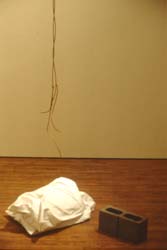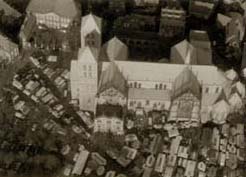-

-

-
Nathan Coley’s Fourteen Churches of Munster 2000 maps out a route through the city of Munster, Germany. Hovering above the city, following the prescribed route, the aerial film was shot from a helicopter seeking out a sequence of churches, scanning for a specific architectural terrain amongst the urban-scape. The helicopter moves quickly between churches and, once the next target is found, slows to circle the building, examining its volume from all sides. The focal points of the fourteen churches offer a visual respite in the film at odds with the historical details fuelling Coley’s work. “In the Munster Stadtmuseum, there is a transcript from a bomber pilot that reads: “The field order was coming in on the teletype and we learned that our target was to be the front steps of Munster Cathedral.”(1) This instruction was given to allied bomber pilots during the intense allied aerial bombing inflicted on Munster late in the Second World War. These churches can be read not only as “the constructed manifestations of human faith, buildings to which the notion of sacrifice pertains as much, if not more, than that of architecture”(2) but as the physical and spiritual heart of the city and powerful vulnerable targets.
It is not the church we want, but the sacrifice; not the emotion of admiration, but the act of adoration: not the gift, but the giving. (John Ruskin, from The Seven Lamps of Architecture, 1848)
Coley’s Fourteen Churches of Munster is removed from the geographical context of Munster and is seen in relation to another history, that of two works by the late Dutch/American artist Bas Jan Ader.
Gavin Wade’s Light Vulnerable Objects threatened by Eight Cement Bricks After Bas Jan Ader 2001 is a reworking of an installation/performance by Bas Jan Ader which took place only once before in the spring of 1970 in Los Angeles. Ader’s original work can never be remade without the presence of Ader himself, who went missing at sea sometime after July 30th 1975 during the second stage of his artwork In Search of the Miraculous. The intention of this reworking is to re-present the process and “space” of Ader’s work as a curatorial artwork.
Ader’s title Light Vulnerable Objects threatened by Eight Cement Bricks seems to indicate an impending fait accompli and describe the image of the work completely. A number of more or less fragile objects are strewn across the floor. Above each “vulnerable object” a heavy brick is hung with a rope. The ropes are cut at a certain moment causing the brick to fall and serving to demolish the object below or to deliver a blow. The effect of the fall demonstrates the vulnerability of the object. In fact one can regard the fall as a “unit of measure” for the fragility of the object, or better yet, as the measure of its resilience.
This work seems to set the tone for Ader’s subsequent work, in which the symbolism becomes centred on his own physical and mental vulnerability as well as being Ader’s last installation before focussing on producing films and photographs of his “performances”. Nightfall 1971 is a film work directly relating to this installation where Ader is seen releasing a brick to extinguish a lightbulb, leaving no trace of light for the celluloid to trace, the proponent disappearing in his own action.
The performance element within Light Vulnerable Objects threatened by Eight Cement Bricks draws parallels to the role of the artist as service provider to the processes of change. Here Ader focuses less on his actions and more on before and after and the nature of the effects of one object on another, even though the human presence is instrumental. Coley’s work also indicates that the role of the artist can exist within a strategically powerful space. Whilst any attempting to objectify structures of emotional and functional complexity leads to no easy answers, art is a keen tool to use in the prodding. How do you decide when to “release” the bricks towards their target? How this decision involves timing, order, planning, impulse, anger or calculation of effect is open to interpretation. This curatorial action is towards the opening of a space for asking questions about the role and nature of art in relation to the targeting of vulnerable moments in human situations.
These works share a space of enquiry where the gap between floating object and ground, earth and heaven, plan and target and art and the world is revealed as vulnerable and open to use. Each work not only targets but highlights a moment of intense potential, a pause or inbetween space awaiting an action whilst generating a sequence of questions. In light of the recent assaults on The World Trade Center and The Pentagon the nature of the space opened up by these works only seems more relevant and important in providing for the future. These works should be seen as ideas towards targeting new space for art to affect, and ultimately towards the repositioning of art within questioning and decision making processes in these vulnerable times.
Gavin Wade 2001Many Thanks to Damian Moppett at Patrick Painter inc and Sophie Von Hellermann.
(1) Brown, Katrina M, Nathan Coley: Fourteen Churches of Munster, Brochure for artwork commissioned by Westfalischer Kunstverein, Munster, 2000.
(2) ibid.orks.
For further information or images please contact Martin Rasmussen: +44 (0)20 7729 9888 or: martin@vilmagold.com
Vilma Gold
Nathan Coley, Bas Jan Ader, Gavin Wade
04 Oct – 28 Oct 2001